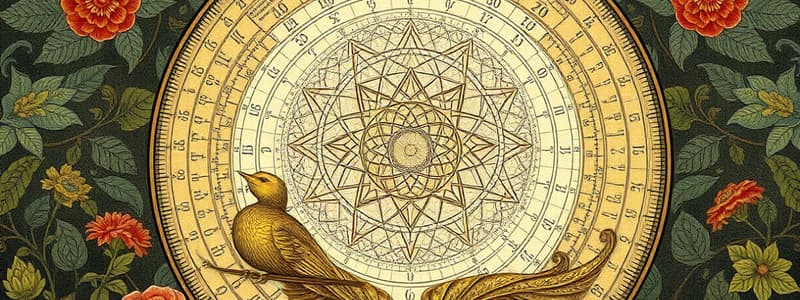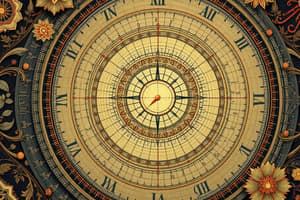Podcast
Questions and Answers
What does the division of a vernier scale signify when it coincides with a main scale reading?
What does the division of a vernier scale signify when it coincides with a main scale reading?
- It shows the exact measurement of an object. (correct)
- It represents the weight of an object.
- It provides an accurate measurement for multiple objects.
- It indicates the depth of an object.
Which of the following best describes the function of a vernier scale?
Which of the following best describes the function of a vernier scale?
- To provide an alternative standard for different measurements.
- To enhance the precision of measurements. (correct)
- To measure angles accurately.
- To serve as a guide for balance.
In what context is a vernier scale commonly used?
In what context is a vernier scale commonly used?
- In assessing electrical conductivity.
- In evaluating material's thermal properties.
- In calculating mass and density.
- In measuring small distances or dimensions. (correct)
What type of measurement is a vernier caliper particularly useful for?
What type of measurement is a vernier caliper particularly useful for?
What is the primary advantage of using a vernier scale over a standard ruler?
What is the primary advantage of using a vernier scale over a standard ruler?
How does one read a measurement using a vernier scale?
How does one read a measurement using a vernier scale?
What is typically the least count of a vernier scale?
What is typically the least count of a vernier scale?
What happens if the vernier scale is not properly aligned with the main scale?
What happens if the vernier scale is not properly aligned with the main scale?
Flashcards
Least Count
Least Count
The smallest measurement that can be made using a vernier scale is called the least count. It is the difference between the values of one main scale division and one vernier scale division.
Vernier Scale
Vernier Scale
The vernier scale is a measuring device that is used to increase the accuracy of a main scale. It consists of a small sliding scale that is divided into smaller divisions than the main scale.
Least Count Formula
Least Count Formula
To calculate the least count of a vernier scale, you divide the value of one main scale division by the number of divisions on the vernier scale.
Calibration
Calibration
Signup and view all the flashcards
Zero Error
Zero Error
Signup and view all the flashcards
Correcting Zero Error
Correcting Zero Error
Signup and view all the flashcards
Screw Gauge
Screw Gauge
Signup and view all the flashcards
Pitch
Pitch
Signup and view all the flashcards
Study Notes
Measurement
- The magnitude of a physical quantity is expressed as the product of its numerical value and the unit.
- Measurement involves comparing the quantity with a known standard quantity of the same nature.
- For different quantities, different units are used.
- A unit is a constant magnitude used to quantify other quantities of the same nature.
- Units are classified as fundamental (or basic) and derived units.
Fundamental Units
- Fundamental or basic units are independent of any other unit.
- The international system of units (SI) uses seven fundamental units: metre (m) for length, kilogram (kg) for mass, second (s) for time, kelvin (K) for temperature, ampere (A) for electric current, candela (cd) for luminous intensity, and mole (mol) for amount of substance.
Derived Units
- Derived units depend on fundamental units.
- Examples of derived units come from calculations involving fundamental quantities.
- Examples include area (m²), volume (m³), speed (m/s), and density (kg/m³).
Systems of Units
-
Common systems of units include CGS (centimeter-gram-second), FPS (foot-pound-second), and MKS (meter-kilogram-second).
-
SI is a modernized form of MKS.
Units of Length
- The SI unit of length is the metre (m).
- Sub-units of the metre include centimeters (cm), millimeters (mm), and micrometers (μm).
- Larger units of length include kilometers (km), astronomical units (AU), light years (ly), and parsecs.
Units of Mass
- The SI unit of mass is the kilogram (kg).
- Smaller units include grams (g) and milligrams (mg).
- Larger units include quintals and metric tonnes.
- The atomic mass unit (amu or u) is used for atomic and subatomic particles.
Units of Time
- The SI unit of time is the second (s).
- Smaller units include milliseconds (ms), microseconds (μs), nanoseconds (ns).
- Larger units include minutes, hours, days, months, years, decades, and centuries.
Least Count
- The least count of a measuring instrument is the smallest measurement that can be accurately taken with that instrument.
- For example, a metre rule has a least count of 1 mm (0.01 m), a vernier caliper has a least count of 0.01 cm and a micrometer screw gauge has a least count of 0.001 cm.
- The smaller the least count, the more precise the measurement.
Vernier Callipers
- A vernier callipers uses two scales for precise length measurement.
- The main scale has larger graduations, while the vernier scale has smaller graduations.
- The difference between the scales, the least count, allows measurements to a higher degree of precision.
Screw Gauge
- A screw gauge, also known as a micrometer screw gauge, measures very small dimensions with high precision.
- It has a main scale and a circular scale.
- The least count of a screw gauge is the value of one division of the circular scale.
Simple Pendulum
- A simple pendulum consists of a heavy bob suspended by a light string from a fixed support.
- The time period of a simple pendulum is related to its length and the acceleration due to gravity by a specific equation.
- The experiment of a simple pendulum shows factors (length, gravity) that affect time periods.
Studying That Suits You
Use AI to generate personalized quizzes and flashcards to suit your learning preferences.




